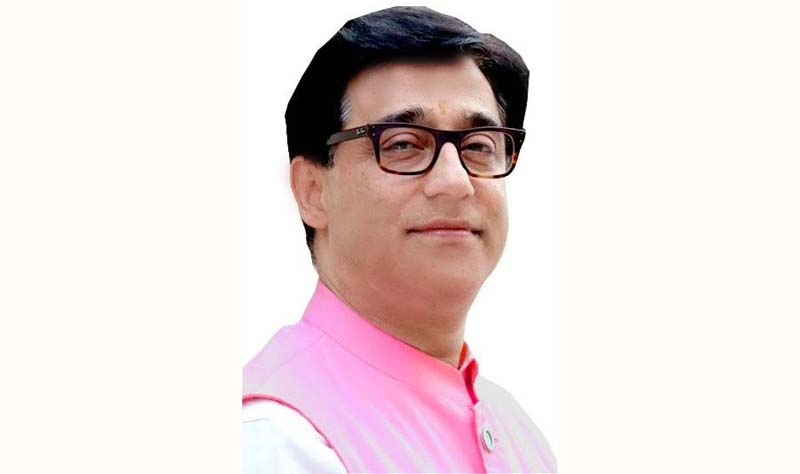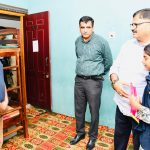I had the honour of attending Sambhaav 2.0, an inspiring event that brought together a diverse array of departments, entrepreneurs, and the vibrant community of small business enterprises from Jammu & Kashmir. The event was dedicated to advancing women empowerment, small business entrepreneurship, and the cultural, economic, and tourism development of the region. Highlights included daily live performances celebrating the melodious symphonies of Bhaderwah, Paddar, Bani, and Kashmiri Rouff, and an impressive showcase of products from Farmer Producer Organisations (FPOs) across ten J&K regions.
The exhibition featured an array of critical products like dry fruits, saffron, and aromatic oils, alongside exquisite crafts such as Kashmiri embroidery, wood carvings, and paper mâché. Notably, the event highlighted custom-made fashion designed by women entrepreneurs from J&K, reflecting the rich cultural heritage and significant progress the region has made. Engaging with the passionate entrepreneurs at the event was truly enlightening, highlighting the region’s dynamic growth and innovative spirit. I was thoroughly impressed with how the entire program was conceptualized and presented.
However, during a discussion with a group of local Kashmiris, I encountered one individual downplaying these efforts, viewing them as insufficient or merely as propaganda rather than acknowledging them as meaningful steps toward progress. This reaction reminded me of the age-old proverbial narrative, “ye che markazachich chaal” (this is a plot of the central government).
Unable to hold back, I reacted and asked them directly.
Me: Are you familiar with the socio-economic development taking place in J&K?
Local Kashmiri: Oh, come on. These are just minor changes. The central government is just trying to show off.
This conversation continued for some time. It became evident that the individual had taken a psychological position of victimhood. He seemed to curse the system and everyone around him for how he was feeling—a false sense of helplessness that is self-created, stemming from a deep-seated victim mentality. He was unwilling to explore or understand the progressive ideas and developments, preferring to see himself as a victim rather than embracing self-empowerment, resilience, and personal accountability.
This situation reminded me of a story from the Solomon Islands, where the tribe’s people don’t cut down trees. Instead, they gather around the trees and curse them for several hours. The collective negativity and belief in the curses cause the trees to wither and fall on their own after a few days. Similarly, the pervasive victim mentality among some Kashmiris acts as a psychological curse, hindering progress and fostering a sense of perpetual helplessness.
Just as the tribespeople’s mindset doomed the trees, the victim mindset can prevent individuals from recognizing and embracing positive changes around them. This mentality acts as a barrier, blinding people to the progress being made and trapping them in a cycle of negativity.
Perhaps, if we take a closer look at Jammu & Kashmir’s advancements across macroeconomic, microeconomic, and social indicators, it becomes clear that significant progress has been made. The region has seen improvements in infrastructure, business opportunities, and social development, demonstrating a remarkable transformation. Yet, the victim mindset can obscure these achievements, preventing individuals from appreciating and benefiting from these positive changes.
Today, J&K ranks 7th among major Indian states with an Human Development Index (HDI) value of 0.634. Globally, it stands at 130th out of 189 countries, placing it in the medium human development category. This reflects notable achievements in education, healthcare, and overall living standards. The Gross State Domestic Product (GSDP) for J&K in the fiscal year 2023-24 is estimated at ₹2.31 trillion (US$ 27.95 billion), with a Compound Annual Growth Rate (CAGR) of 8.84% from 2018-19 to 2023-24. This growth is driven by sectors like agriculture, horticulture, and services. The per capita income in J&K has risen to ₹1,04,000 in 2022-23, up from ₹88,000 in 2018-19, indicating improved economic conditions. Recent data from the Periodic Labour Force Survey (PLFS) shows a decrease in urban unemployment from 13% in 2022 to 10.7% in 2023. Worker Population Ratio (WPR) has increased from 33.4% to 35.4% and Labour Force Participation Rate (LFPR) rose from 38.4% to 39.7%.
Skill development and entrepreneurship in Jammu & Kashmir are being significantly enhanced through various initiatives. The Pradhan Mantri Kaushal Vikas Yojana (PMKVY) has trained over 30,000 youth in key sectors such as IT and tourism, equipping them with vital skills to boost employability and economic growth. Additionally, Hausla 2.0 aims to enhance financial inclusion by training 400 women entrepreneurs, empowering them with the knowledge and skills to start and manage their own businesses, thereby fostering economic independence. The JK Startup Portal further supports this entrepreneurial spirit by streamlining support mechanisms for startups, providing essential resources and guidance to help new businesses navigate the challenges of growth and innovation. Together, these programs are driving the economic development and modernization of the region.
The government has also launched several impactful initiatives to drive development and empowerment in Jammu & Kashmir. The Back to Village (B2V) Program aims to empower rural communities by fostering direct interaction between government officials and villagers, addressing local issues, and promoting grassroots development. Mission Youth focuses on youth empowerment through various employment and education schemes, providing opportunities for skill development and career growth to the younger population. Additionally, significant progress has been made in attracting investments to the region, with 456 Memorandums of Understanding (MOUs) signed for potential investments worth ₹23,152 crore (US$ 3.17 billion). These initiatives collectively contribute to the socio-economic advancement of Jammu & Kashmir, fostering a more inclusive and prosperous future for its residents.
Despite the substantial progress in various sectors of J&K, a pervasive sense of victimhood among some people continues to hinder full realization of this progress. This persistent sense of victimhood among some people in Jammu & Kashmir, despite substantial progress in various sectors, can be understood as a form of cognitive dissonance. This psychological discomfort arises when their perception of being victim’s, conflicts with the visible advancements and improvements in the region.
In case of J&K, this cognitive dissonance is occurring because the belief in perpetual victimhood (a deeply ingrained self-invented-concept) is clashing with the tangible evidence of progress and development made in J&K. This clash or conflict is generating psychological discomfort because the observed improvements challenge the established narrative of being neglected or oppressed.
In fact, when one see oneself as a victim individually or collectively, it starts to give them a satisfying sense of identity in a non-satisfying way. People start feeling good about feeling bad, without even realising this and they feel safe and secure in that state of mind. This mindset leads them to reject anything beneficial because they have already internalized the belief that nothing good can align with their view of the world, where everyone around them is perceived as an enemy or as someone with harmful intentions.
Leon Festinger’s theory of cognitive dissonance can explain why individuals might cling to a victim identity. When people’s actions conflict with their self-concept, they experience discomfort (dissonance). Embracing a victim identity can resolve this dissonance by attributing failures to external factors, rather than confronting uncomfortable truths about oneself.
Henri Tajfel’s Social Identity Theory suggests that individuals derive a part of their identity from the groups they belong to. If a group sees itself as oppressed or victimized, this collective victimhood can reinforce individual members’ sense of identity. This sense of victim identity is where individuals or groups perceive themselves as victims of circumstances, societal structures, or other people’s actions. This identity can become central to how they see themselves and interact with the world.
In the context of Jammu & Kashmir, Tajfel’s Social Identity Theory can explain the pervasive sense of victimhood among some individuals and groups. This belief can lead to labelling others and invalidating their experiences. People justify their victimhood through mental constructs that align with their identity and experiences and reject everything else around them that may be even intended for their benefit. For example, an individual might justify ongoing financial difficulties by blaming economic policies of the government, rather than exploring personal financial mismanagement. This mindset allows individuals to maintain their sense of victimhood, aligning with their identity and experiences, while rejecting opportunities for positive change.
I recall an experience shared by a friend mine, about the pre-1990 period during Jagmohan’s tenure as Governor of Jammu and Kashmir. Jagmohan had made significant progress in road development in the region. My friend mentioned that he was in a conversation with some friends during that time and praised Jagmohan’s efforts. He said that as soon as he expressed his appreciation, another local friend in the group immediately retorted, “Don’t sell us Jagmohan, under the garb of development.”
This reaction highlights the deep-seated sense of dissonance and victimhood within the psyche of many individuals in the region. Despite clear evidence of development and progress, the pervasive victimhood mentality prevents people from acknowledging and appreciating these positive changes. Instead, they remain fixated on their perceived grievances and suspicions, unable to see beyond their entrenched narratives. This example highlights how a victimhood mentality can obscure reality and hinder progress, perpetuating a cycle of negativity and resistance to positive change.
I recall another incident that was shared with me by an academician friend who was a member of the Academic Council at some university in Kashmir. Some years back, during an academic council meeting, the discussion focused on grants provided by the University Grants Commission (UGC). My friend recounted that one of the local members expressed concern that these funds should be scrutinized carefully, suggesting that they might be intended to undermine the university’s autonomy.
This incident vividly illustrates the deep-seated sense of fear and apprehension prevalent in the mindset of some in the region. The suggestion that financial support from a national body could be a ploy to subvert local autonomy reflects a profound distrust and scepticism. This reaction is indicative of a cognitive dissonance rooted in a victimhood mentality, where even well-intentioned actions are viewed through a lens of suspicion and potential harm.
The apprehension expressed by the local member is not merely about the specific grants but reveals a broader psychological pattern. This pattern is characterized by a persistent belief that external entities have ulterior motives, reinforcing a narrative of perpetual victimization. Such a mindset can significantly impede progress, as it creates barriers to accepting support and resources that could facilitate development and academic growth.
Moreover, this example underlines how the victimhood mindset can infiltrate various aspects of life, including academia. This mentality keeps individuals and institutions locked in a defensive posture, preventing them from fully capitalizing on opportunities for improvement and advancement.
I think, the historical, political, and social dynamics of the Kashmir and the influence of religious radicalization has significantly contributed to a collective identity that is deeply rooted in perceived victimization by many.
Feeling good about feeling bad has become a psychological phenomenon where many individuals have learnt to derive a perverse sense of satisfaction or identity from their suffering. This can be because their victimhood provides them with a sense of certainty, identity, or even moral superiority. People often view the world through a “veil of conditioning,” which refers to the preconceived notions and biases formed by their upbringing, culture, religion, and personal experiences. The conditioning of individuals and communities significantly shapes their identity and worldview, often leading them to adopt a victim mindset. For instance, a person raised in a strict religious environment might interpret their struggles through the teachings of their faith, believing they are being tested or persecuted. Also, when a society collectively sees itself as a victim, it often seeks a convenient scapegoat, leading to the targeting of communities, institutions with different beliefs and the governments.
Historically, various communities have grappled with a victimhood mentality, leading to prolonged suffering and unfulfilled objectives. In Nazi Germany, for example, the regime blamed Jewish immigrants for the nation’s financial crises and moral decay, resulting in the Holocaust and devastating impacts on millions of lives. Similarly, after the Armenian Genocide, Armenians faced immense trauma and displacement. While their victimhood garnered international sympathy, their prolonged struggle for justice and recognition continues to this day.
In the United States, African Americans, post-Reconstruction, faced systemic discrimination. Despite the Civil Rights Movement making significant strides, the victimhood mentality that developed contributed to cycles of poverty and limited progress in some communities. According to a 2019 report by the Economic Policy Institute, the median income for African American households was 61% of that for white households, illustrating the persistent economic disparities.
In the context of Jammu and Kashmir, the victimhood mindset has been perpetuated by political vested interests. For decades, certain political factions have kept the victimhood narrative alive to serve their political and personal motives. They have often prioritized keeping the bitterness and resentment towards nation alive rather than fostering reconciliation and helping people recognize their inherent benefits and advantages. This strategy has maintained a sense of perpetual grievance and hindered the region’s ability to fully embrace and benefit from developmental initiatives.
This has been further augmented through a systematic radicalization and religious indoctrination. In recent years the problem of radicalization has been exacerbated by a relentless information war waged both from within and outside Kashmir. Countries like Pakistan, with support from others have been instrumental in perpetuating this narrative of victimhood through sophisticated information campaigns. These efforts aim to manufacture and feed a sense of victimhood, attract international sympathy, and keep the region in a state of perpetual unrest.
In Japan, there is a traditional art form known as Kintsugi, which literally means “golden joinery.” This ancient practice involves repairing broken pottery by mending the areas of breakage with lacquer mixed with powdered gold, silver, or platinum. Rather than disguising the damage, Kintsugi highlights the fractures, embracing them as part of the object’s history. The philosophy behind Kintsugi is deeply rooted in the idea of embracing imperfection and seeing beauty in the broken.
Just as Kintsugi highlights and enhances the fractures in pottery with gold, the people of Kashmir can acknowledge and integrate their historical and contemporary traumas into their collective identity, transforming these experiences into sources of strength and resilience. This shift in perspective can help overcome the pervasive sense of victimhood, fostering a new narrative of empowerment and growth. Kintsugi teaches that imperfection is not something to be ashamed of but something to be celebrated. This can help shift the victim mindset to one of self-compassion and acceptance, fostering a healthier self-image and reducing the internal conflict of cognitive dissonance.
The repaired pottery tells a new story, one of resilience and beauty. Similarly, societies and individuals can create new narratives for themselves, focusing on their strengths and potential rather than their victimhood. This narrative shift can inspire hope and motivate proactive efforts towards positive change. By embracing their challenges and viewing them as opportunities for transformation, the people of Kashmir can recognize their progress and potential, paving the way for a more hopeful and united future.
(The Author is Vice Chancellor, Shri Vishwakrma Skill University)








